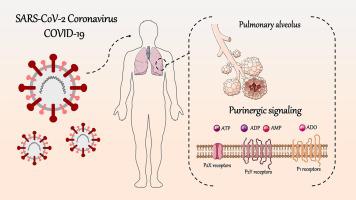International Immunopharmacology ( IF 4.8 ) Pub Date : 2021-09-13 , DOI: 10.1016/j.intimp.2021.108150 Júlia Leão Batista Simões 1 , Helena Fornari Basso 2 , Greicy Cristine Kosvoski 2 , Jullye Gavioli 1 , Filomena Marafon 3 , Charles Elias Assmann 4 , Fabiano Barbosa Carvalho 5 , Margarete Dulce Bagatini 6

|
The etiological agent of coronavirus disease (COVID-19) is the new member of the Coronaviridae family, a severe acute respiratory syndrome coronavirus 2 virus (SARS-CoV-2), responsible for the pandemic that is plaguing the world. The single-stranded RNA virus is capable of infecting the respiratory tract, by binding the spike (S) protein on its viral surface to receptors for the angiotensin II-converting enzyme (ACE2), highly expressed in the pulmonary tissue, enabling the interaction of the virus with alveolar epithelial cells promoting endocytosis and replication of viral material. The infection triggers the activation of the immune system, increased purinergic signaling, and the release of cytokines as a defense mechanism, but the response can become exaggerated and prompt the so-called “cytokine storm”, developing cases such as severe acute respiratory syndrome (SARS). This is characterized by fever, cough, and difficulty breathing, which can progress to pneumonia, failure of different organs and death. Thus, the present review aims to compile and correlate the mechanisms involved between the immune and purinergic systems with COVID-19, since the modulation of purinergic receptors, such as A2A, A2B, and P2X7 expressed by immune cells, seems to be effective as a promising therapy, to reduce the severity of the disease, as well as aid in the treatment of acute lung diseases and other cases of generalized inflammation.
中文翻译:

靶向嘌呤能受体抑制 SARS-CoV-2 感染引起的肺组织细胞因子风暴
冠状病毒病 (COVID-19) 的病原体是冠状病毒科的新成员,是一种严重急性呼吸系统综合症冠状病毒 2 型病毒 (SARS-CoV-2),是困扰世界的大流行病的元凶。单链 RNA 病毒能够感染呼吸道,其病毒表面的刺突 (S) 蛋白与血管紧张素 II 转换酶 (ACE2) 的受体结合,在肺组织中高度表达,使病毒具有肺泡上皮细胞,促进病毒物质的内吞和复制。感染会触发免疫系统的激活、嘌呤能信号的增加以及作为防御机制的细胞因子的释放,但反应会变得夸大并引发所谓的“细胞因子风暴”,出现严重急性呼吸系统综合症(SARS)等病例。其特征是发烧、咳嗽和呼吸困难,可发展为肺炎、不同器官衰竭和死亡。因此,本综述旨在汇编免疫系统和嘌呤能系统之间涉及的机制并将其与 COVID-19 相关联,因为调节免疫细胞表达的嘌呤能受体(例如 A2A、A2B 和 P2X7)似乎是有效的有前途的疗法,可以减轻疾病的严重程度,并有助于治疗急性肺部疾病和其他全身性炎症病例。











































 京公网安备 11010802027423号
京公网安备 11010802027423号